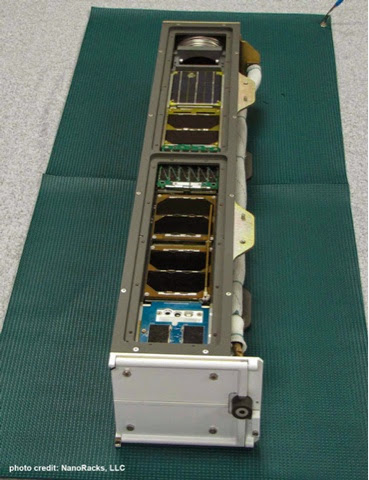You may have never given it a second thought. When the news says the ISS launched another dozen CubeSats you may have thought ‘that’s nice’ and finished your breakfast but wouldn’t you like to know how they do it?
Consider that launching a satellite has always been a rather expensive endeavor, until recently. Yes the ISS is already up there in space, but they can’t just open a window and toss it out. Actually they have to be precise in placing the CubeSats in orbit JUST so.
So, how is it done? They have two devices on the ISS that can handle this and they are called CubeSat deployers. One is Japan’s experimental “Satellite Orbital Deployer” (J-SSOD) and the other is the “NanoRacks CubeSat Deployer”.
*Pictured is just one of over a dozen NanoRacks CubeSat deployers with customer CubeSats integrated for flight. The CubeSats are ejected through the white deployer doors at bottom of the photo. The deployer access panels have been removed showing [Bottom to Top] UAPSat, ArduSat-2, SkyCube, LitSat-1 and LituanicaSAT-1.
A CubeSat deployer takes a satellite to be deployed and places it into position for one of the space stations robotic arms to grab it. The robotic arm in turn takes the CubeSat and places it in the exact position to allow for the exact orbit needed. The upcoming launch to the ISS (currently August) to resupply the ISS will also deliver Cyclops Cyclops (aka: Kinetic Launcher for Orbital Payload Systems) will give the ISS a third tool for release of these satellites.
The Cyclops with an attached satellite will utilize the existing airlock slide table and be sent through to where it is grabbed by the robotic arm and then taken to the appropriate position. Above are two pictures of the airlock slide table.
Why are so many deployment stations required? First of all the CubeSat’s don’t always fit the launcher. A CubeSat sounds, well, like a cube. Not so. They come in all shapes some even spherical and this presents a problem. They each can weigh between 110 & 220 pounds and have very varied missions. Besides their small size, they come from all areas: NASA, a commercial company, a school or university, or an individual; an individual? Building a CubeSat is both affordable and there is the possibility that NASA could launch it for you through their ‘CubeSat Launch initiative. Of course the due date from submission was November 2013 so maybe you missed the window. Still, they could still launch it for you; might cost $100,000 but at least the satellite itself was cheap!
The satellite missions range from concentrating on the weather to pictures from the sky, to climate changes or even the varied gases in the atmosphere. For 2014 you can still WIN a DoD or NASA launch of your CubeSat by checking out “CubeSat-based Science Missions for Geospace and Atmospheric Research” and completing your application by May 12th, 2014.
Back to the deployment; Cyclops is innovation and modernization of technology at its best. Above please find a picture of the Cyclops hardware. This design is durable and is expected to hold up to the several launches a year for the remainder of the years of the station’s life. Of course there is always the possibility that NASA comes up with something even better or a new generation is needed for some far-out new CubeSat.





No comments:
Post a Comment